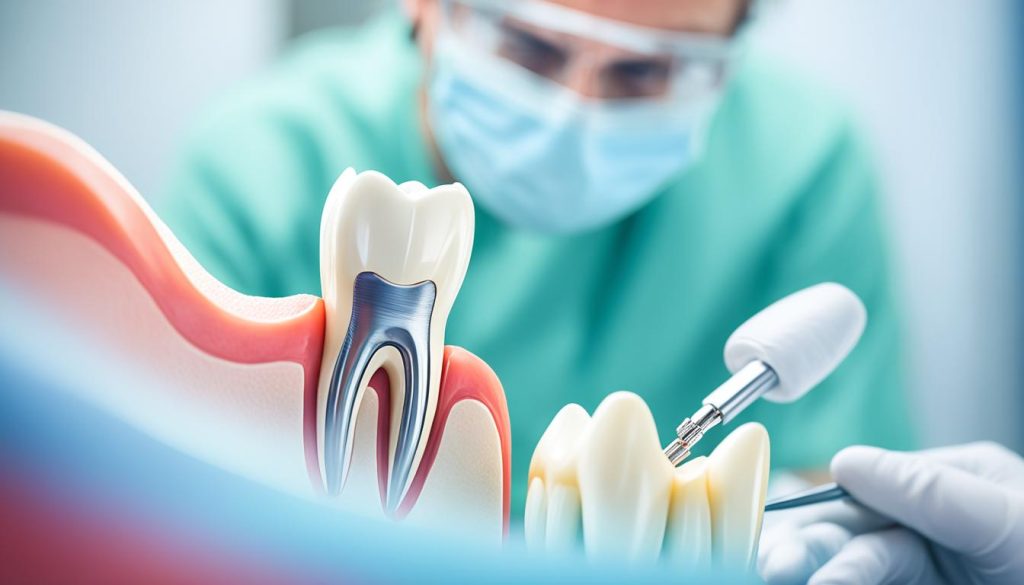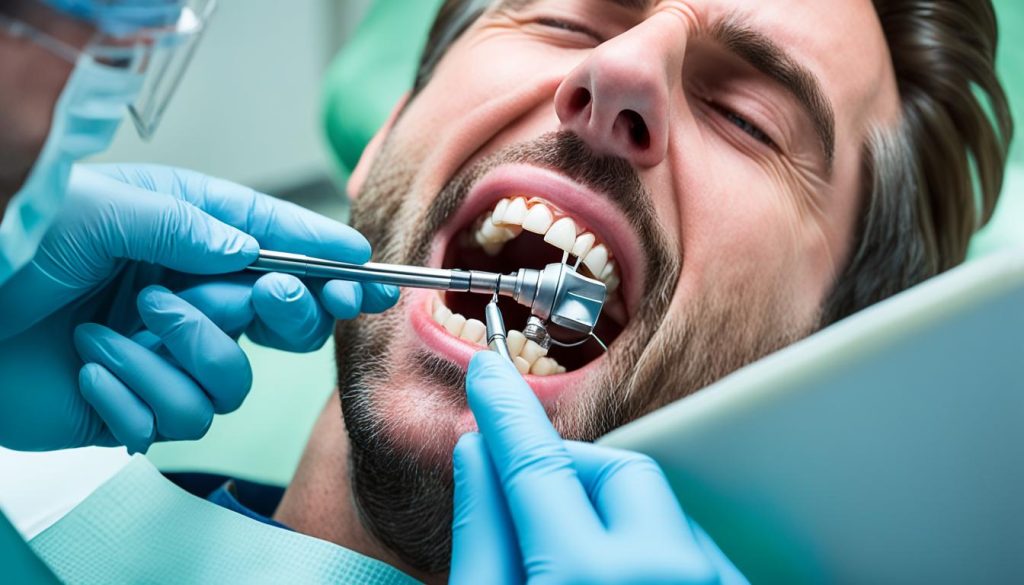Recovering from a root canal procedure is a common concern for many patients. If you are wondering how long it takes to recover from a root canal, you’re in the right place. In this section, we will explore the root canal healing process and discuss the timeline for root canal recovery. Understanding what to expect post-treatment is essential for a smooth and successful recovery.
After a root canal treatment, which involves removing the infected pulp and sealing the tooth, most patients can expect to start feeling back to normal within a couple of days. The root canal recovery period is relatively short, thanks to advances in dental techniques and materials. However, it is important to note that individual recovery times may vary.
To ensure proper healing, it is crucial to follow the aftercare instructions provided by your endodontist. This may include avoiding chewing on the treated tooth, taking prescribed pain medication, and favoring the side of the mouth that underwent the root canal. By following these guidelines, most post-treatment symptoms are mild and can be managed with over-the-counter analgesics.
Next, we will delve deeper into what a root canal procedure entails and how it helps alleviate tooth pain and restore dental health. Read on to learn more about the process of a root canal treatment.
What is a Root Canal?
A root canal is a dental procedure performed to treat infections in the tooth pulp, which is the innermost layer of the tooth. When dental decay or damage reaches the pulp, it can lead to inflammation or infection. During the root canal procedure, the infected pulp is carefully removed, and the tooth tooth abscess to prevent reinfection. This helps save the natural tooth and alleviate pain caused by tooth decay or infection.

Signs You May Need a Root Canal
If you are experiencing tooth pain, it is important to pay attention to these signs that may indicate the need for a root canal:
- Severe Toothache: Tooth pain that is intense and persistent can be a sign of dental issues that require prompt attention.
- Dental Decay: Dental decay that has reached the innermost layer, the pulp, may necessitate a root canal for proper treatment.
- Swollen Gums: Swollen gums around a specific tooth can signal an infection that may require a root canal to resolve.
- Sensitivity to Hot and Cold: If you experience discomfort or pain when consuming hot or cold food and beverages, it could be an indication of underlying dental problems.
- Pimple or Boil on the Gums: The development of a pimple or boil on the gums near the affected tooth can suggest the presence of an infection that may require a root canal.
If you are experiencing any combination of these symptoms, it is vital to consult with a dentist or endodontist for a comprehensive evaluation and appropriate treatment. They will be able to assess your condition and determine if a root canal procedure is necessary to save your tooth and alleviate your discomfort.
Ignoring these signs can lead to further oral health complications and may require more invasive treatments in the future. Seeking timely dental care when experiencing these symptoms can potentially save your natural tooth and alleviate your pain.
Remember, early intervention and regular dental check-ups can help detect dental issues before they worsen. So, if you are experiencing any tooth pain, severe toothache, dental decay, swollen gums, or sensitivity to hot and cold, don’t hesitate to reach out to your dentist for a proper diagnosis and appropriate treatment.

The Process of a Root Canal Procedure
The root canal procedure involves several steps to effectively treat the infection in the tooth and save its structure. A root canal treatment is commonly performed when the pulp of a tooth becomes infected or inflamed due to dental decay or trauma. Let’s take a closer look at each step of the root canal procedure:
Step 1: Removal of Infected Pulp
The first step involves the careful removal of the infected pulp from the inside chamber of the tooth. This is done to eliminate the source of infection and alleviate any associated pain or discomfort.
Step 2: Sterilization of Tooth Cavity
Once the infected pulp is removed, the tooth cavity is thoroughly sterilized to ensure that no bacteria or debris are left behind. This sterilization process helps prevent reinfection and promotes proper healing.
Step 3: Sealing of Tooth
After the tooth cavity is sterilized, it is sealed with a special material known as gutta-percha. This filling material creates a barrier that prevents bacteria from re-entering the tooth, further protecting it from future infections.
Step 4: Crown Placement (if necessary)
In some cases, a crown may be placed over the treated tooth to provide additional strength and protection. A dental crown is a custom-made cap that covers the entire tooth, restoring its function and aesthetics.
Through the completion of these steps, a root canal treatment effectively removes the infected pulp, sterilizes the tooth cavity, seals the tooth to prevent reinfection, and restores the tooth’s structure if needed. This comprehensive procedure aims to alleviate pain, save the natural tooth, and improve overall dental health.

Managing Pain and Discomfort
After undergoing a root canal procedure, it is not uncommon to experience some degree of pain and discomfort during the recovery process. However, there are several measures you can take to manage these symptoms and make your healing process more comfortable.
If you are experiencing mild to moderate pain, your endodontist may prescribe pain medication to help alleviate your discomfort. Alternatively, over-the-counter analgesics such as ibuprofen or acetaminophen can also be effective in reducing post-treatment pain.
In addition to pain, you may also notice swelling in the surrounding gum tissues as a result of the procedure. To help reduce swelling, you can apply ice packs to the affected area for 15 minutes at a time, several times a day.
During the recovery period, you may find that you have increased sensitivity while chewing. This is a normal side effect of the procedure and should diminish on its own within a few days. In the meantime, you can try sticking to softer foods that require less force to chew.
Frequently rinsing your mouth with warm saltwater can also provide relief and promote healing. Simply dissolve a teaspoon of salt in a cup of warm water and swish it around in your mouth for about 30 seconds before spitting it out.
Remember, it is essential to follow the aftercare instructions provided by your endodontist to ensure proper healing and minimize any discomfort. If you have any concerns or if your pain and swelling worsen, it is important to reach out to your dental care provider for guidance.
| Managing Pain and Discomfort | What to Do |
|---|---|
| Pain | – Take prescribed pain medication. – Use over-the-counter analgesics. – Apply ice packs to reduce swelling. |
| Swelling | – Use ice packs on the affected area. – Rinse with warm saltwater. |
| Sensitivity While Chewing | – Stick to softer foods. – Take smaller bites and chew slowly. |
Follow-Up Care and Maintenance
After a root canal procedure, proper follow-up care is essential for long-term dental health. Taking the necessary steps to care for your treated tooth can help ensure its longevity and prevent any potential complications. Below are some key aspects of post root canal care and maintenance to keep in mind:
1. Visit a General Dentist for Permanent Restoration
Following the root canal procedure, it is important to schedule an appointment with a general dentist to receive a permanent restoration, such as a crown. This restoration not only provides added protection to the treated tooth but also helps prevent reinfection. Your dentist will create a customized crown that fits snugly over the tooth to restore its strength and functionality.
2. Practice Good Oral Hygiene
Maintaining good oral hygiene is crucial in preserving the health of your treated tooth and the surrounding teeth. Brush your teeth at least twice a day using a soft-bristled toothbrush and fluoride toothpaste. Don’t forget to gently brush the treated tooth and pay attention to the gumline. Additionally, floss daily to remove plaque and food particles from between your teeth and around the treated area.
3. Avoid Inflammatory Foods and Drinks
During the recovery period, it is advised to avoid spicy foods or alcoholic beverages that can cause inflammation. These substances can impede the healing process and increase discomfort. Opt for a balanced diet that includes nutritious foods that promote overall oral health, such as fruits, vegetables, lean proteins, and dairy products.
4. Contact Your Dental Office for Guidance
If you have any questions or concerns during the recovery period, do not hesitate to reach out to your dental office for guidance. They will be able to provide personalized advice and address any issues that may arise. Open communication with your dental care team can help ensure a smooth recovery and optimal oral health.

Following these post root canal care and maintenance guidelines will contribute to the successful healing of your treated tooth and help prevent reinfection or other complications. Remember to maintain regular dental check-ups and cleanings to monitor the health of your teeth and receive professional guidance on maintaining oral hygiene.
Potential Complications and How to Avoid Them
While most root canal procedures are successful, there can be potential complications that patients should be aware of. These complications include root canal re-infection, post-treatment pain, and improper restoration.
Root Canal Re-infection
One of the main complications of a root canal procedure is the risk of re-infection. If proper oral hygiene is not maintained after the root canal, bacteria can enter the tooth, leading to an infection. To prevent re-infection, it is crucial to follow the aftercare instructions provided by the endodontist and maintain good oral hygiene. This includes brushing and flossing regularly, using a mouthwash recommended by your dentist, and scheduling regular dental check-ups to monitor the health of the treated tooth.
Post-treatment Pain
Some patients may experience post-treatment pain or discomfort after a root canal procedure. However, this pain is usually temporary and can be managed with over-the-counter pain medication as recommended by your dentist. It is important to note that if the pain persists or worsens, you should contact your dentist for further evaluation and possible treatment.
Improper Restoration
Improper restoration of the treated tooth can lead to complications and potential failure of the root canal procedure. It is essential to ensure that a permanent restoration, such as a crown, is properly placed by a qualified dentist or endodontist. This restoration helps protect the treated tooth from further damage and prevents future problems.
To avoid complications associated with root canal procedures, it is recommended to follow all post-treatment instructions provided by your dentist, maintain good oral hygiene practices, and promptly address any concerns or issues that arise during the recovery process. By taking these precautions, you can increase the chances of a successful root canal treatment and maintain the health of your treated tooth.
Conclusion
Recovering from a root canal procedure typically takes a few days, with most patients experiencing mild symptoms that can be managed with over-the-counter medication. The root canal healing process involves following the recommended aftercare instructions and seeking necessary follow-up care to facilitate the healing process and prevent complications. It is crucial to address any concerns or questions with your dental care team to ensure a smooth recovery and long-term dental health.
During the root canal recovery time, it is essential to practice proper post root canal care. This may include avoiding chewing on the treated tooth, taking prescribed pain medication, and favoring the side of the mouth that underwent the root canal. Following these guidelines can help alleviate tooth pain and ensure a successful recovery.
Remember, your dental care team is there to support you throughout the root canal healing process. By investing in your oral health and prioritizing post root canal care, you can expect a more comfortable recovery and maintain long-term dental well-being.




